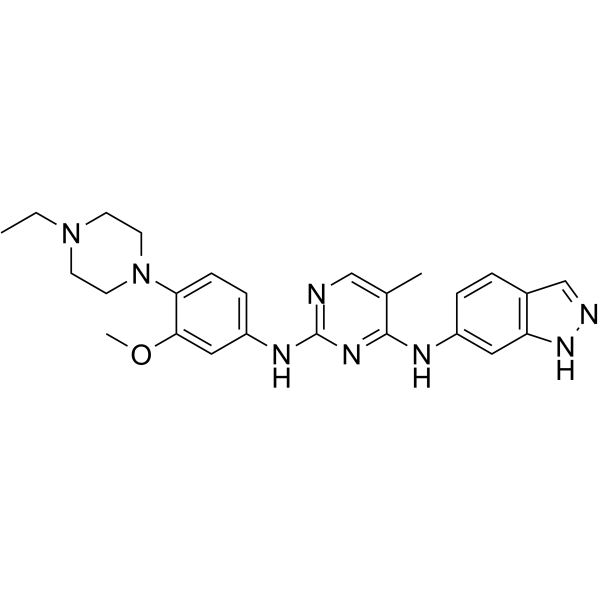| Description |
PDGFR-IN-1 (compound 7m) is a potent and orally active PDGFR (platelet-derived growth factor receptor) inhibitor, with IC50 values of 2.4 and 0.9 nM for PDGFRα and PDGFRβ, respectively. PDGFR-IN-1 displays robust antitumor effects and low toxicity, and can be used to study osteosarcoma[1].
|
| Related Catalog |
|
| Target |
IC50: 2.4 nM (PDGFRα), 0.9 nM (PDGFRβ)[1]
|
| In Vitro |
PDGFR-IN-1 (compound 7m) (0-0.4 μM, 48 h) inhibits osteosarcoma cancer cells (U2OS, MG63, MNNG/HOS, and SAOS-2) proliferation and colony formation[1]. PDGFR-IN-1 (0-0.4 μM, 48 h) induces cell-cycle arrest in a dose-dependent manner[1]. PDGFR-IN-1 (0-1.6 μM, 48 h) induces MNNG/HOS and MG63 cell apoptosis in a dose-dependent manner[1]. PDGFR-IN-1 (0-0.4 μM, 15 min) inhibits the expression of α-tubulin in both MNNG/HOS and MG63 cells[1]. PDGFR-IN-1 (0-0.4 μM, 48 h) inhibits PDGFRβ phosphorylation and downstream signaling transduction (p-STAT3, p-AKT, and p-ERK)[1]. PDGFR-IN-1 (0-0.4 μM, 48 h) significantly inhibits osteosarcoma cancer cell migration and invasion by downregulating the expression of FAK, as well as the distribution in the leading edge of cells[1]. Cell Proliferation Assay Cell Line: Human osteosarcoma cancer cell lines (U2OS, MG63, MNNG/HOS, and SAOS-2)[1] Concentration: 0.1, 0.2, and 0.4 μM. Incubation Time: 48 h Result: Showed strong antiproliferative activity against MG63, U2OS, MNNG/HOS, and SAOS-2, with IC50 values of 0.44, 0.42, 1.03, and 0.37 μM, respectively. Showed dose-dependent inhibition colony formation. Cell Cycle Analysis Cell Line: MG63 and MNNG/HOS cells[1] Concentration: 0, 0.1, 0.2, 0.4 μM Incubation Time: 48 h Result: Induced G2/M cell-cycle arrest in MNNG/HOS and G0/G1 cell-cycle arrest in MG63 cells in a dose-dependent manner. Apoptosis Analysis Cell Line: MG63 and MNNG/HOS cells[1] Concentration: 0, 0.4, 0.8, 1.6 μM Incubation Time: 48 h Result: Induced MNNG/HOS and MG63 cell apoptosis in a dose-dependent manner. Immunofluorescence Cell Line: MG63 and MNNG/HOS[1] Concentration: 0, 0.1, 0.2, 0.4 μM Incubation Time: 15 min Result: Inhibited the expression of α-tubulin in both MNNG/HOS and MG63 cells, inhibited proliferation and reduced the PDGFRβ fluorescence intensity in a concentration-dependent manner. Western Blot Analysis Cell Line: MG63 and MNNG/HOS[1] Concentration: 0, 0.1, 0.2, 0.4 μM Incubation Time: 48 h Result: Effective inhibited PDGFRβ phosphorylation and downstream signaling transduction (p-STAT3, p-AKT, and p-ERK) at the cellular level.
|
| In Vivo |
PDGFR-IN-1 (BALB/c mice, MNNG/HOS xenograft mouse, 15, 30 mg/kg, orally, daily for 14 days) significantly suppresses tumor growth, exhibits a stronger antitumor efficacy with low toxicity[1]. PDGFR-IN-1 (C57/BL6 mice, 40, 80 mg/kg, orally, daily for 10 days) is safe for in vivo investigations[1]. PDGFR-IN-1 (Sprague-Dawley rats, 20 mg/kg PO or 4 mg/kg IP, once) shows a favorable profile with a high maximum concentration and exposure, an acceptable half-life , and a good oral bioavailability[1]. Pharmacokinetic Parameters of PDGFR-IN-1 in male Sprague-Dawley rats[1]. 7m route IP PO dose (mg/kg) 4 20 Cmax (ng/mL) 78.3 75.2 t1/2 (h) 2.86 2.12 AUC0-∞ (ng/mL*h) 211.3 664.7 F (%) 62.9 Animal Model: Sprague-Dawley rats (male, 200-260 g, Six rats, two groups)[1] Dosage: 20 mg/kg (PO) or 4 mg/kg (IP) Administration: PO, IP, once (Pharmacokinetic Analysis) Result: Showed a favorable profile with a high maximum concentration and exposure, an acceptable half-life , and a good oral bioavailability. Animal Model: BALB/c mice (18-20 g, MNNG/HOS xenograft mouse, eight groups)[1] Dosage: 15, 30 mg/kg Administration: Orally, daily for 14 days Result: Significantly suppressed tumor growth, exhibited a stronger antitumor efficacy, did not cause significant body weight or organ weight (heart, lung, liver, spleen, or kidney) changes, strongly suppressed the proliferation of tumor cells and induced apoptosis in tissues of the tumor. Animal Model: C57/BL6 mice[1] Dosage: 40, 80 mg/kg Administration: Orally, daily for 10 days Result: Did not reveal any obvious morphological aberration in organ tissues.
|
| References |
[1]. Chen X, Liu L, Liu P, et al. Discovery of Potent and Orally Bioavailable Platelet-Derived Growth Factor Receptor (PDGFR) Inhibitors for the Treatment of Osteosarcoma. J Med Chem. 2022;65(7):5374-5391.
|
